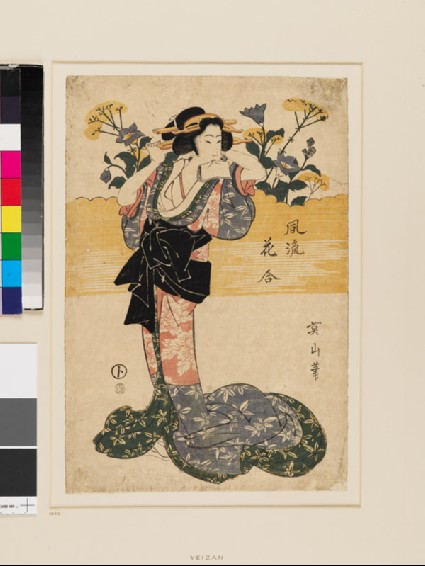Browse: 10610 objects
Elegant Flower Viewing
-
Details
- Associated place
- Date
- early - mid-19th century
- Artist/maker
-
Kikukawa Eizan (1787 - 1867) (designer)
- Associated people
-
Yamaguchi Tōbei (active c. 1805 - 1895) (publisher)
- Material and technique
- nishiki-e (multi-block) woodblock print, printed with water-based vegetable pigments
- Dimensions
-
mount 55.6 x 40.5 cm (height x width)
print 34.3 x 23.5 cm (height x width)
- Material index
- Technique index
- Object type index
- No. of items
- 1
- Credit line
- Presented by Mrs Allan and Mr and Mrs H. N. Spalding, 1952.
- Accession no.
- EAX.4751
-
Further reading
Oxford: Ashmolean Museum, 24 August-30 November 2005, Beauties of the Four Seasons, Mitsuko Watanabe, ed. (Oxford: Ashmolean Museum, 2005), no. 35 on p. 74, illus. p. 75
Glossary (2)
nishiki-e, vegetable pigments
-
nishiki-e
Nishiki-e literally means 'brocade pictures' and refers to multi-coloured woodblock prints.
-
vegetable pigments
Vegetable pigments were used to create coloured dyes for Japanese prints, paintings, and textiles. These pigments often faded over time due to the chemical reactions they underwent.
Location
-
- currently in research collection
Objects are sometimes moved to a different location. Our object location data is usually updated on a monthly basis. Contact the Jameel Study Centre if you are planning to visit the museum to see a particular object on display, or would like to arrange an appointment to see an object in our reserve collections.
Publications online
-

Beauties of the Four Seasons
A beauty with rolled-up sleeves is holding a kaeshi (pocket paper) in her mouth while she adjusts her kanzashi. Her kimono is of a bamboo leaf design with an area of peony flowers with three contrasting colours. In the background, ominaeshi (maiden flower) and kikyō (Japanese bellflower) are in bloom, which are both ‘seven flowers for autumn’. Hana-awase, its title, is a competition for the most beautiful flowers and also for exchanging poems with the theme of flowers. Here it clearly suggests a competition between beautiful women. -

Beauties of the Four Seasons
A beauty with rolled-up sleeves is holding a kaeshi (pocket paper) in her mouth while she adjusts her kanzashi. Her kimono is of a bamboo leaf design with an area of peony flowers with three contrasting colours. In the background, ominaeshi (maiden flower) and kikyō (Japanese bellflower) are in bloom, which are both ‘seven flowers for autumn’. Hana-awase, its title, is a competition for the most beautiful flowers and also for exchanging poems with the theme of flowers. Here it clearly suggests a competition between beautiful women.
© 2013 University of Oxford - Ashmolean Museum

